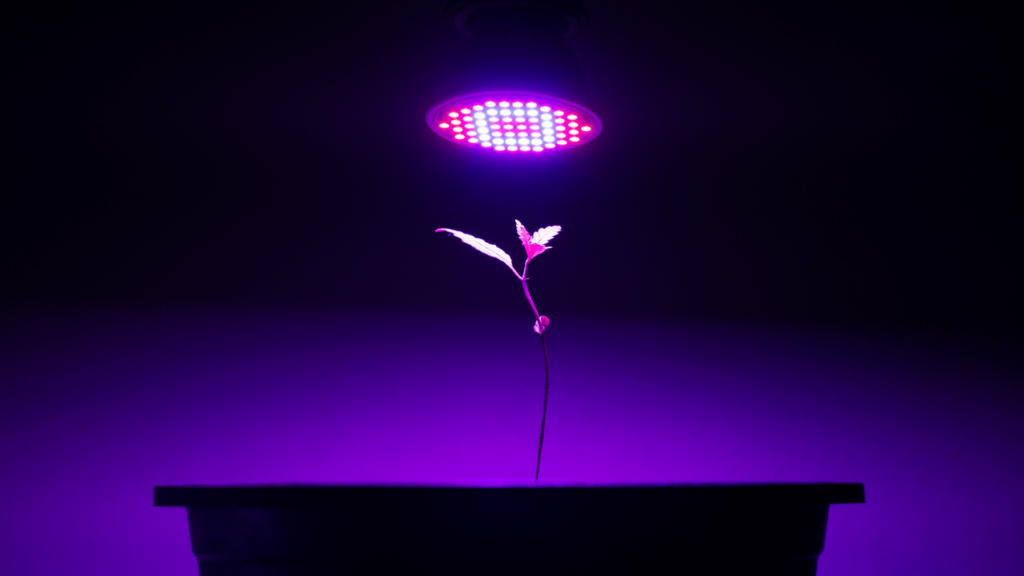Learning how to grow weed indoors isn’t an easy process, and one of the most challenging elements to master is the lighting. Choosing the best indoor lights is a tad more complicated than just finding a cheap LED light and hanging it from the rafters.
The lights you use can significantly affect your crop health, growth rate, and ultimate yield – all of which impact your high.
To make the most of your crop, whether it be to sell or to enjoy at home with your friends, here is everything you need to know about indoor marijuana grow lights and how to choose the right one for your operation.

Cannabis plants go through all the same processes other plants do – specifically, photosynthesis.
Photosynthesis is when plants turn light energy into chemical energy, which is used as food. It fuels plant growth and is as necessary as breathing is for humans.
Grow lights are essential for growing weed indoors where natural sunlight may be limited or insufficient. They can mimic and supplement natural sunlight, providing the necessary light spectrum for photosynthesis and the overall growth and development of the plants.
Grow lights enable year-round cultivation, regardless of seasonal changes or geographical location. This is essential for weed, which has specific light and dark periods that trigger flowering. Cultivators can induce flowering and control the entire growth cycle by manipulating the light cycle with grow lights.
But not all light is created equal. While plants can use almost any light to grow, specific wavelengths provide more light energy and better growth.
Growers have been cultivating for decades, and the indoor grow game has only improved in recent years. Of all the lights out there, these common, specialized lights are the best variety for your indoor operation.
LED grow lights, short for light-emitting diodes, are a newer light model in the community. They’re powerful and great for the environment.
Heat emissions on LED grow lights are also significantly less than the other grow lights on this list. This low heat emission allows growers to place the lights closer to plants without risking heat damage. It also helps maintain a more controlled and stable environment within the growing space.
LED lights have a longer lifespan compared to traditional light sources, reducing the need for frequent replacement. This saves money and ensures a consistent light source for plant growth.
Popular models also let you change the light spectrum to coincide with your crop’s growth phase, which allows you to optimize every growth stage.
LED grow lights are typically compact and come in various shapes and sizes, making them easy to install in different setups. This flexibility is especially beneficial in indoor gardening, where space may be limited.
The only con is the upfront cost. LED lights are pretty expensive. However, when you compare the money you’ll save on electricity bills (from both lights and cooling systems), they work out to be more affordable in the long run.
HID (high-intensity discharge) grow lights are the most common grow lights you’ll find in indoor grow operations, mainly because the lights are affordable and emit a lot of light – which helps plants grow fast and buds to grow big.
HID grow lights are used with reflective umbrellas or hoods, which amplify the light and heat radiation onto the plants below. Both components are relatively cheap because they are so widely used. You’ll also need a ballast to regulate light flow during different growth stages.
There are two main types of HID grow lights:
On the flip side, these lights release a lot of light and heat. This can increase your electricity bill in a grow room because you’ll need heavy-duty cooling systems. And because the lights run at such high temperatures and frequencies, you must replace them more often than other options like LED lights.
The most affordable and flexible option on this list is CFL (compact fluorescent lamps) lights. These are the same white bulbs you’ll find in most office buildings. They are readily available at most stores.
CFLs are low-level, not as hot or bright as LED or HID lights. Sizing is also very flexible.
The low-intensity emissions also make them especially friendly to new clones and growth. This makes them an excellent option for small-scale growers just starting their operations. They’re gentle but still effective.
Unfortunately, this is their downside as well. You must invest in other lights when your crop reaches the flowering stage. CFL lights don’t have the power to encourage sufficient growth. Bulking buds with them is virtually impossible.
Bulking buds refers to the stage of the plant’s growth cycle where the focus is on increasing the size and density of the flowering buds. This stage is crucial for maximizing the yield of high-quality, potent flowers.
To support bulking buds, growers often adjust environmental factors like light intensity, nutrient levels, and humidity. The use of grow lights is essential during the flowering stage, as they provide the necessary spectrum and intensity of light to promote robust bud development.
The visible light spectrum has seven colors (red, orange, yellow, green, cyan, blue, and violet) with different wavelengths – between 400 and 700 nm. Cannabis plants like different light spectra during various stages of weed growth.
If you cater to each state’s light spectrum preference, you can optimize the plant growth for big, healthy buds worth their weight in gold.
Let’s look at which light-spectrum cannabis plants prefer during the seedling, vegetative, and flowering stages.
To make the most of your new growth, provide them ample blue light. Blue light, which has a shorter wavelength, is essential for early-stage growth and development.
The seedling stage is fragile, and giving your new growth enough energy to create their first shoots is essential. Too high a wavelength risks drying the plants or burning them, and too little won’t give them the necessary boost they need.
During the vegetative stage, marijuana plants start to see a significant boost in growth. During this period, it’ll evolve from a small sapling into something resembling traditional images of marijuana plants. It’s also during this time that it achieves its quickest vertical growth.
The vegetative stage also prefers blue light but with a higher frequency than the seedling phase, between 400 and 500 nm.
The flowering stage is the last push before harvest, and if you play your cards right with grow lights, you can bulk your buds with good lights. In the flowering stage, marijuana plants want red light at around 700 nm. You can opt for orange or yellow light if you don’t have red.
Now you know what indoor grow lights are and which light spectra work best with the different growth stages. But that’s not all you need to consider when choosing your new indoor grow lights.
The size of your indoor grow area can heavily influence what lights you use.
If your room is small, cheaper lights like HID lights won’t be a good option. They’ll turn the growing area into a hothouse, and you might have to install a heavy-duty cooling unit, which likely will do little good.
In this case, LED lights are your best bet. Otherwise, opt for CFL lights if you can’t afford LEDs.
Larger grow areas are more forgiving of heavy-duty heat-emitting lights. This is also great, considering decking out a massive grow area in LED lights will be expensive for a newcomer. You can opt for HID lights and move over to LED when you start bringing in steady income.
Considering the effects of your light energy efficiency is essential for your electricity bill. Grow lights like HID lights are notorious for their power and their ability to bulk buds. But they’re resource-intensive. Invest in LED lights or a more efficient lighting system to save money in the long run.
High heat emissions, especially in small buildings without cooling systems, can negatively impact new growth.
LED lights are your best bet if you need low heat emissions in your space. It would likely work out cheaper in the end, as you won’t have to spend thousands on a cooling system to combat the heat from your lights.
If you want to start growing weed, equipment like grow lights is a necessary expense. But how much you spend depends on your current budget.
While it might be the easiest to buy cheap lights right off the bat, it often works out more expensive in the long run, and you’ll have to move over to better lights in the future anyway.
Investing in good lights, like LED lights, is a high upfront cost but cheaper when compared to replacing cheap bulbs every few months, paying for cooling systems, and paying for high electricity bills.
If you have the money but balk at the upfront costs, push through and invest in good lights – especially if you want to continue to grow weed for a long time.
We only suggest starting with cheaper lights if your operation is very small.
Some grow lights cause eye strain and damage your eyes. High heat emissions and an insufficient cooling system also risk your employees developing heat stroke. So, consider your comfort and safety when choosing lights.
Light positioning is essential for good growth. As a general rule, the younger the marijuana plants are, the further away the lights need to be.
Your lights should be 25 to 35 inches from the seedlings during the seedling stage. This provides enough light to grow but doesn’t risk drying them or the soil out.
When they enter the vegetative stage, move the lights closer to the new growth, between 12 and 25 inches. Play it safe for intense lights with high heat emissions like HID lights and keep them further from the new growth.
During the flowering stage, move the lights as the plants grow. Maintain a distance of 18 and 24 inches between the lights and the canopy. If you want more intense buds, decrease the distance to 18 inches.
Of course, all this depends on your weed strain and the grow lights you use. Use your first crop as a control test and see what works to optimize future growth.
Light maintenance is essential, especially if you invested money in them. Keeping them functioning and clean also optimizes their output and plant growth.
So, after every harvest, dedicate a day to cleaning all your grow room lights. Unplug the lights and let them cool off completely. Most cannabis grow lights come with cleaning instructions, which you should follow.
If they don’t have instructions, follow these steps:
If you want to start growing your own weed, you need the right grow lights. There are many options on the market, and the jargon can be confusing. Use this article as a guide to choose the best option for you so that you can start growing quality cannabis indoors.
In the meantime, check out Embarc for all your weed needs. Our high-quality buds, concentrates, vapes, edibles, and topicals are unlike anything you’ve ever tried. Visit your nearest Embarc location today!
